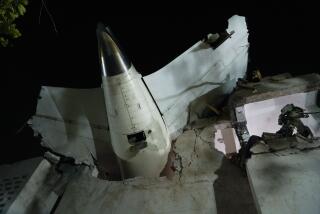‘We Had a Number of Emergencies’ : Pilot of Crippled Jetliner Had Doubts of Safe Return
- Share via
SAN FRANCISCO — The pilot of United Airlines’ Flight 811 admitted Friday that he “had a few doubts” whether his jumbo jetliner--crippled by a gaping hole ripped in the fuselage and two of its four engines dead--was going to make it back to Honolulu last week.
Capt. David Cronin told reporters that the cockpit crew’s initial calculations showed that the Boeing 747 might have been losing altitude too fast to reach the airport before plunging into the Pacific.
Cronin said the 10-by-20-foot section of fuselage blew out in “a tremendous explosion” as the plane climbed out of Honolulu on Feb. 24 at between 22,000 and 23,000 feet. The cause of the blast, which swept nine passengers to their deaths and injured 27 others, has not been determined. Structural failure, rather than a bomb, is suspected.
“We had a number of emergencies, not just one,” Cronin said as the Los Angeles-based cockpit crew members made their first public appearance at San Francisco International Airport on Friday.
“We had explosive decompression,” he said. “That’s an emergency in itself. Next we had No. 3 engine fail. That’s also an emergency in itself. Next we had a fire in No. 4 engine. That’s another emergency in itself.
“Next we had to dump fuel . . . in order to stay airborne,” he said. “Handling the aircraft in the situation we had was very difficult. . . .
‘A Bit of Concern’
“All these things . . . generated a bit of concern.”
Cronin--who remained at the controls throughout the flight--said he sent the second officer, Mark Thomas, 46, below to check the damage in the passenger cabin.
“When I got downstairs (and saw the hole), I knew we had a serious problem,” Thomas said. “It was like looking outside through a picture window.”
Cronin said the look on Thomas’ face when he returned told everything about the situation below.
“He didn’t have to say a word,” the captain said. “I said a prayer for (the passengers), and got back to business.”
Cronin, a 59-year-old who has flown for 38 years as an Air Force and commercial pilot, said he and his crew members elected to rely on their experience, rather than the book, to bring the big plane home.
According to the book, he said, a pilot faced with sudden decompression is supposed to lower the landing gear immediately to create drag, dropping rapidly to lower altitudes, where both passengers and crew will be able to breathe more easily.
But Cronin said that despite the fact that the cockpit’s emergency oxygen masks failed to deploy properly, none of the crew members seemed to be having breathing difficulties. And every foot of altitude was needed to bring the big plane back to Honolulu.
So, for the time being, he left the gear up, the captain said. “I calculated this risk was necessary.”
Initially, it did not seem to make much difference.
Al Slader, the 48-year-old co-pilot, said that as he watched the altimeter, the big plane continued to drop, first below 15,000 feet, then below 12,000.
“We found we were unable to hold altitude, even with the No. 1 and No. 2 engines at full power,” Slader said. “I remember Dave asking Mark, ‘What’s the maximum thrust we can get out of those engines?’ And Mark replied, ‘Whatever it takes.’
“I kept looking at the distance measuring equipment, trying to figure out the rate of descent we had . . . whether we were, in fact, going to make it back to Honolulu. . . . “
Gradually, as the plane started to reach the denser air at lower altitudes, the rate of descent began to slow, and Cronin said his decision to keep the gear up was vindicated.
“We broke through the clouds at 4,000 feet,” the captain said. “The rate of descent slowed to 50 feet per minute, and we were only 17 miles out . . . I could see the airport. . . . I was confident we were going to make it. . . . If we’d lowered the gear earlier, we wouldn’t have had that altitude.”
But that did not mean they were home safe, yet.
The big plane, hampered by the loss of two engines and the drag created by the gaping hole on the right side, was still hard for the pilot to control.
And Cronin suspected that the plane’s right-hand flaps and slats--slabs of metal that extend from the trailing and leading edges of the wings to provide the increased lift necessary for normal takeoffs and landings--might have been damaged by debris from the ruptured fuselage.
The book calls for a 20-degree extension when attempting a landing with two engines out, but when the crew members tried a 5-degree extension, they noticed that the slats on the right side were stuck at 3 degrees, creating an uneven trim that added to the difficulty of controlling the plane.
Once again, the crew members’ experience took precedent. They elected for a compromise between asymmetry and lift--a compromise that required considerable effort by the pilot to keep the big plane steady.
“Al suggested 10 degrees,” Cronin said. “We went to 10. It worked fine.”
As the jumbo jet lined up for final approach, Cronin finally lowered the gear, knowing that with two engines out, that meant a critical increase in drag that precluded any opportunity to abort the landing.
“There wasn’t going to be any second chance,” Cronin said.
Seconds later, the big plane touched down in what Slader described as “as smooth a landing as I’ve ever sat through.”
Within a few minutes, the passengers and crew had been evacuated by emergency chutes.
Cronin, who has just one flight left--a final trip to Australia--before he reaches the mandatory retirement age of 60, then walked around the plane to survey the damage.
“I saw that tremendous hole,” he said. “I saw how the blades on that engine were all chewed up.
“My reaction was, I can’t tell you what my reaction was, like, ‘Oh, (pause) you know what. Oh, dear.’ . . .
“I was very thankful we’d made it.”
More to Read
Sign up for Essential California
The most important California stories and recommendations in your inbox every morning.
You may occasionally receive promotional content from the Los Angeles Times.












